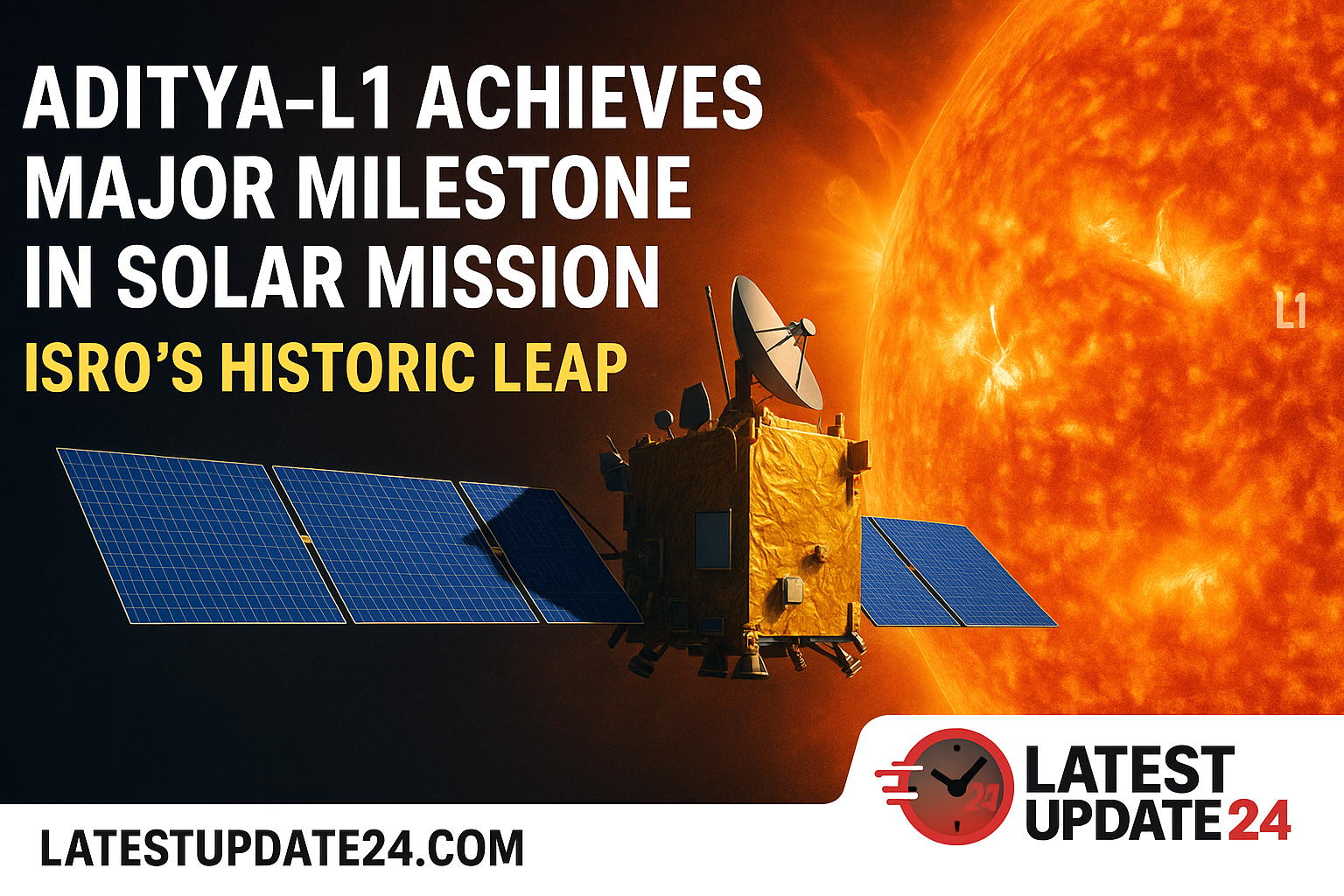India’s Solar Breakthrough: Aditya-L1 Mission Achieves Historic Space Milestone

July 2025, Bengaluru: India’s first solar space observatory, Aditya-L1, has successfully reached a significant operational milestone. Launched by ISRO (Indian Space Research Organisation), the mission has now begun full-scale scientific observations from its station at Lagrange Point 1 (L1). This achievement marks a new era for India in solar physics and space weather forecasting, as the nation joins an elite group with deep-space solar observation capabilities.
What is the Aditya-L1 Mission?
The Aditya-L1 mission was launched on September 2, 2023, aboard the PSLV-C57 from Sriharikota. It is India’s first dedicated solar mission designed to study the outer atmosphere of the Sun from a gravitationally stable point in space called Lagrange Point 1. Located 1.5 million kilometers from Earth, this position enables uninterrupted observation of the Sun without any eclipse interruptions or Earth’s shadow.
The mission’s name “Aditya” means “Sun” in Sanskrit, and “L1” refers to the location of its halo orbit near Lagrange Point 1. This mission is a collaborative effort between various ISRO centers and Indian academic institutions, including the Indian Institute of Astrophysics (IIA) and Inter-University Centre for Astronomy and Astrophysics (IUCAA).
Scientific Objectives of Aditya-L1
Aditya-L1 is equipped with seven advanced payloads to carry out a range of scientific studies related to solar physics. The main objectives of the mission include:
- Understanding the dynamics of the solar corona and solar heating
- Studying solar flares, sunspots, and coronal mass ejections (CMEs)
- Measuring the magnetic field of the solar corona for the first time from space
- Investigating the origin and properties of solar wind
- Monitoring space weather to protect satellites, astronauts, and communication systems on Earth
Latest Milestone: Full Payload Activation
As of July 2025, ISRO confirmed that all seven payloads aboard Aditya-L1 are operational and transmitting data. Instruments like the Visible Emission Line Coronagraph (VELC), Solar Ultraviolet Imaging Telescope (SUIT), and Solar Low Energy X-ray Spectrometer (SoLEXS) are collecting detailed observations of the solar atmosphere.
VELC, the mission’s most advanced instrument, is built to study the solar corona by blocking direct sunlight and observing emissions. It is expected to unravel mysteries of why the Sun’s corona is hotter than its surface—one of the biggest unsolved questions in astrophysics.
Why Lagrange Point 1 is Ideal for Solar Study
Aditya-L1’s orbit near L1 allows it to have a constant view of the Sun without being affected by the Earth’s rotation or shadow. This unique position ensures real-time solar observations, making it perfect for early warnings of solar storms that can disrupt satellite operations, power grids, and even aviation systems.
India’s Rising Space Leadership
The success of Aditya-L1 has put India on the global map of solar research. It complements previous missions like Chandrayaan and Mangalyaan, and aligns with ISRO’s future plans including Gaganyaan (India’s manned space mission) and Chandrayaan-4. Several global space agencies, including NASA and ESA, have acknowledged the mission’s significance.
What’s Next for Aditya-L1?
Over the next five years, Aditya-L1 will continuously collect solar data. This information will help in:
- Improving solar storm forecasting models
- Advancing space-weather prediction technology
- Enhancing our understanding of the Sun-Earth connection
- Supporting global space agencies and researchers through open data collaborations
Conclusion
With Aditya-L1, ISRO has added another shining feather to its cap. The mission not only showcases India’s technological capabilities but also emphasizes its contribution to global science. As solar activity increases during this cycle, Aditya-L1 will provide invaluable insights that benefit science, technology, and daily life on Earth.
📡 Stay updated on ISRO missions, tech news, and global space science with LatestUpdate24.com.
🔗 Related Articles:
- Chandrayaan-4 Mission Update: Lunar Goals in Sight
- Gaganyaan 2025: India’s First Human Spaceflight Details
ISRO’s ambitious Aditya-L1 mission marks a historic milestone in India’s journey into space-based solar observation. According to the official ISRO Aditya-L1 mission page, the spacecraft has successfully positioned itself at the first Lagrangian point (L1), located approximately 1.5 million kilometers from Earth. This position enables continuous observation of the Sun without any eclipses or obstructions.
This mission not only highlights ISRO’s technical expertise but also places India alongside elite nations in heliophysics. Aditya-L1’s instruments are designed to study solar flares, coronal mass ejections, and other solar phenomena that affect Earth’s climate and satellite communication. These efforts align with global solar missions, including NASA’s Parker Solar Probe and other heliophysics missions.









